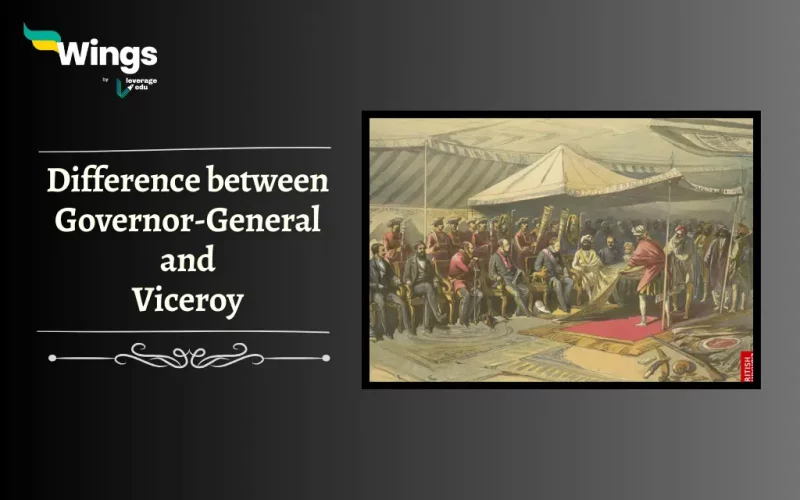Governor Generals and Viceroys served different periods in history. The difference between the Governor-General and the Viceroy dates back to the colonial era. Moreover, the term “Governor General” was more commonly used in the earlier stages of British colonial rule, while “Viceroy” became the preferred title during the later periods. In the era of colonial history and administration, the titles of Governor General and Viceroy often arose. These two roles were pivotal in the governance of various territories during the British colonial era, including India. While they might seem similar at first glance, there are significant differences that set them apart.
Some important differences between a Governor-General and a Viceroy are:
| On the basis of – | Governor-General | Viceroy |
| Territorial Scope | A crucial distinction lies in the territories they oversaw. A Governor General typically governed a specific colony or region, such as Canada or Australia. | In contrast, a Viceroy presided over larger and more complex territories, often entire subcontinents like British India. |
| Authority and Rank | Governor Generals had more limited authority, primarily managing day-to-day affairs within their respective regions. | Viceroys held a higher rank and had greater authority compared to Governor Generals. A Viceroy answered directly to the British monarch and had more extensive powers in matters of governance, diplomacy, and military control. |
| Symbolic Role | Governor Generals, while important, didn’t carry a higher level of pomp and ceremony. | The titles carried different symbolic weights. Viceroys were seen as representatives of the British crown and wielded immense power and prestige. They often hosted grand ceremonies and were involved in state functions, emphasizing their regal status. |
Governor-General in India
Table of Contents [show]
In the year 1833, the British Parliament enacted the Charter Act, renaming the position of Governor General of Bengal to Governor General of India. Moreover, Lord William Bentinck assumed the role as the first Governor General of India, hence overseeing administrative functions and reporting to the Court of Directors of the East India Company. Lord Mountbatten, serving as Viceroy of India from February to August 1947, marked the end of the Governor Generalship. Consequently, Chakravarti Rajagopalachari held the distinction of being both the first and last Governor-General of independent India.
Also Read: Complete List Of Governor General Of India
Viceroy in India
People appointed to govern a foreign land on behalf of a monarch are termed Viceroys. Following the 1857 Revolt, the British assumed the status and authority of the Viceroys. Lord Canning held the position as the first Viceroy of India. Concluding this historical era, Lord Mountbatten served as the final Viceroy from February to August 1947, overseeing the transition of India to independence.
Also Read: List of Viceroys of India
What was the Chronological Shift?
The shift from Governor General to Viceroy in India is an illustrative example. Initially, India was governed by Governor Generals, but in 1858, Lord Canning became the first Viceroy of India, marking a transition to more centralized control.
What was their Legacy and Impact?
The legacies of Governor Generals and Viceroys varied. Some Viceroys are remembered for significant policy changes and reforms, such as Lord Curzon’s administrative reforms in India. Governor Generals often played crucial roles in shaping the early history of colonies, but their influence was typically more localized.
Also Read: Who was the First Governor General of India?
In conclusion, while both Governor Generals and Viceroys were pivotal figures in the British colonial administration, their roles, authorities, and historical contexts set them apart. Governor Generals governed specific colonies, while Viceroys oversaw larger territories, holding greater power and prestige. Understanding these differences provides valuable insights into the complex history of colonial governance.
FAQ’s
The primary difference lies in their authority and territorial scope. Governor Generals governed specific regions or colonies within India, such as Bengal or Madras. In contrast, Viceroys presided over the entire Indian subcontinent. Viceroys held higher rank and more extensive powers, answering directly to the British monarch, while Governor Generals had more localized authority.
Yes, there was a significant transition. Initially, India was governed by Governor Generals appointed by the British East India Company. However, after the Indian Rebellion of 1857, the British Crown took direct control of India. The title changed from Governor General to Viceroy, symbolizing the shift to centralized rule and emphasizing the authority of the British Crown.
Governor Generals played vital roles in shaping the early administrative and political landscape of specific regions within India. They implemented policies and reforms within their territories. In contrast, Viceroys oversaw comprehensive policies and governance for the entire subcontinent. They had greater authority and were instrumental in implementing significant reforms and changes in India’s governance, infrastructure, and modernization.
If you want to read more articles like this, you can check out the Modern History of India here. Also, you can visit our general knowledge page on Indian History!
 One app for all your study abroad needs
One app for all your study abroad needs















 45,000+ students trusted us with their dreams. Take the first step today!
45,000+ students trusted us with their dreams. Take the first step today!
